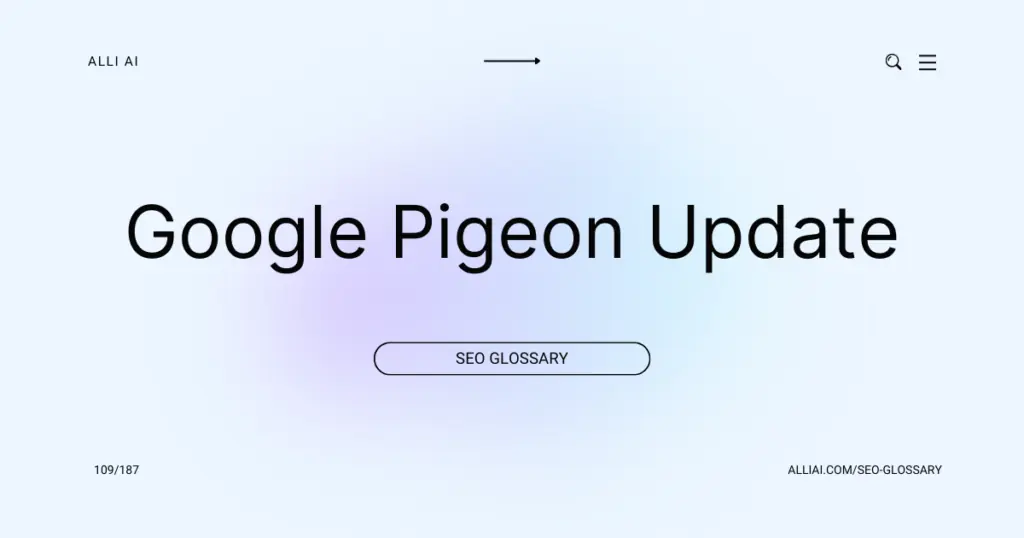What Does Google Pigeon Update Mean?
The Google Pigeon Update is an update to Google’s algorithm introduced in 2014 aimed at improving the quality and relevance of local search results. This update enhances the ability to tie local search results more closely to traditional web search ranking signals, resulting in more accurate and useful outcomes for searches that have local intent.
Where Does Google Pigeon Update Fit Into The Broader SEO Landscape?
The Google Pigeon Update, released in 2014, is a significant algorithm update that specifically aimed to improve local search results. It emphasizes location and distance as key ranking factors, closely tying local search results more tightly with standard search ranking signals. This update enhances the relevance and accuracy of results for users conducting local searches, potentially affecting the visibility of local businesses in Google Maps and Google Search results. By prioritizing local information, Pigeon plays a vital role in the broader SEO landscape by influencing how businesses optimize their content and online presence for geographically-related searches. This includes optimizing for local keywords, ensuring accurate and consistent local business listings, and improving local citation and review management strategies.
Real Life Analogies or Metaphors to Explain Google Pigeon Update
Imagine a town where the main street businesses used to feel overshadowed by big billboards pointing to distant malls for similar services. The Google Pigeon Update is like the town planners updating the local map, giving clearer, bigger signs to those main street shops. Now, when locals or visitors ask for directions, they’re more likely to find those neighborhood businesses instead of being directed far away. This shift helps the townsfolk discover and support local gems, enhancing the economic and social fabric of their own community.
How the Google Pigeon Update Functions or is Implemented?
The Google Pigeon Update, released in 2014, primarily aimed to enhance local search results by improving the relevance and accuracy based on the user’s location. It integrates more traditional web search ranking signals into local search results. This means that local search results are influenced by domain authority, backlinks, and other SEO factors similar to standard page rankings.
Pigeon emphasizes the importance of local directories, with increased visibility for local directory sites in search results, encouraging businesses to keep listings accurate and up-to-date. The update uses location and distance as key criteria in ranking the results, providing preference to businesses closer to the searcher’s location.
The algorithm ties deeper into Google’s web search capabilities, including the knowledge graph, spelling correction, synonyms, and more, enhancing the overall search experience for local queries. This also suggests a greater integration between Google Maps and Google Search, with both platforms sharing local search data.
By improving location-based technology, Pigeon allows for more precise localisation, improving the granularity of local SEO down to neighborhoods and other small regions. This gives smaller, local businesses a better chance at competing with larger companies on a more level playing field in terms of visibility in search.
Impact Google Pigeon Update has on SEO
The Google Pigeon Update significantly impacts SEO performance and website rankings by prioritizing local search results, thereby enhancing the visibility of local businesses in both the Google Maps and traditional Google search results. This update improves the algorithm’s location and distance ranking parameters, making the search engine more sensitive to the geographical proximity of businesses when users perform local searches. Websites optimized for local SEO, including those maintaining strong local directory and listing presences, see improved rankings, while those that are not locally optimized may experience a drop in their visibility. Additionally, by focusing on more relevant and precise local search results, the update enhances user experience, providing users with results that more accurately reflect their immediate geographical area. This has a direct effect on traffic for local businesses, potentially increasing foot traffic and local interactions.
SEO Best Practices For Google Pigeon Update
1. Ensure Your Website is Mobile-Friendly: Use responsive design, increase site speed, and ensure navigation is easy on mobile devices.
2. Optimize Local Listings: Verify and update your business information on Google My Business and other local listing sites.
3. Use Local Keywords: Incorporate location-based keywords into your website’s content, titles, meta descriptions, and URLs.
4. Acquire Local Backlinks: Obtain backlinks from local news outlets, community blogs, and other local businesses.
5. Optimize for Local Searches: Customize content to reflect local news, events, or activities to increase relevance in local search queries.
6. Collect and Respond to Reviews: Encourage customers to leave reviews on your Google My Business and other review sites, and respond professionally to both positive and negative reviews.
7. Create Local Content: Publish content that speaks to local issues, events, or activities to engage a local audience.
8. Use Schema Markup: Implement local business Schema markup to help search engines understand your business location and offerings.
9. Optimize Google My Business: Regularly update your profile with new photos, accurate business hours, and respond to Q&A.
10. Monitor Performance and Adapt: Use tools like Google Analytics and Google Search Console to track traffic and search performance, adapting strategies as necessary based on performance data.
Common Mistakes To Avoid
1. Ignoring Local SEO: The Pigeon Update prioritizes local search results, thus businesses should fully optimize for local SEO. Ensure NAP (Name, Address, Phone Number) consistency across all listings, and claim or create a Google My Business profile.
2. Poor Quality Backlinks: Post-Pigeon, local directory and citation sites gained in importance. Keep an eye on the quality of directories you’re listed in; prioritize reputable, well-regarded sites specific to your locality or industry.
3. Lack of On-Site Local Signals: Not incorporating location-based keywords into title tags, meta descriptions, and throughout the website content can be a misstep post-Pigeon. Include city, region, or neighborhood names where relevant.
4. Neglecting User Experience (UX): Websites with poor usability can perform poorly in search results. Mobile responsiveness, fast loading times, and intuitive navigation become critical in keeping both users and search engines satisfied.
5. Failure to Gather Reviews: Reviews, particularly on Google My Business, play a crucial role in local rankings. Actively encourage satisfied customers to leave positive feedback. Monitor and respond to reviews, showing engagement and customer care.
6. Overlooking Local Content: Websites that fail to produce local content may miss out on local search queries. Develop content that speaks directly to a local audience, such as news about local events, features on community activities, or guides relevant to the local area.
7. Incomplete Google My Business Profile: An incomplete profile can hurt your local SEO. Ensure all information is up-to-date and fully detailed, including operating hours, services offered, and images of your business.






